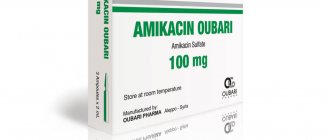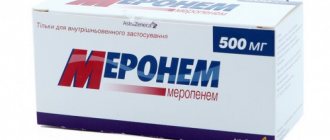Write a review
Reviews: 0
Manufacturers: Aventis Pharma (UK)
Active ingredients
- Cefotaxime
Disease class
- Bacterial meningitis, not elsewhere classified
- Acute and subacute endocarditis
- Acute upper respiratory tract infection of multiple and unspecified localization
- Pneumonia without specifying the pathogen
- Acute lower respiratory tract respiratory infection, unspecified
- Bronchitis, not specified as acute or chronic
- Skin abscess, boil and carbuncle
- Peritonitis
- Pyoderma
- Local infection of skin and subcutaneous tissue, unspecified
- Cholecystitis
- Cholangitis
- Infectious myositis
- Tendon sheath abscess
- Other infectious (teno)synovitis
- Abscess of the bursa
- Other infectious bursitis
- Osteomyelitis
- Surgical practice
- Urinary tract infection without established localization
- Inflammatory diseases of the male genital organs, not elsewhere classified
- Other inflammatory diseases of the female pelvic organs
- Inflammatory diseases of the female pelvic organs in diseases classified elsewhere
Clinical and pharmacological group
- Not indicated. See instructions
Pharmacological action
- Antibacterial
- Bactericidal
Pharmacological group
- Cephalosporins
Other names and classification
In pharmacology, this drug is found under different names.
The drug is used to treat infectious diseases and their complications in adults and children.
International nonproprietary name
Cefotaxime.
Latin name
Claforan.
Trade names
Claforan.
Registration number
P N008945-170807.
ATX
J01DD01 - Cefotaxime.
Indications for use
The range of infectious diseases for which Klaforan can be used is quite wide. Cefotaxime can have a beneficial effect on the patient’s body when:
- Kidney and urinary tract infections
- Infectious pathologies of the respiratory system
- Otolaryngological infectious processes (nose, ear and throat)
- Endocarditis - infectious lesions of the inner cardiac layer
- Meningitis – infectious lesions of the membranes of the brain and spinal cord
- Gynecological infections
- Gonorrhea is a sexually transmitted infection.
Do you feel a burning sensation in your vagina? It is necessary to establish the cause and prescribe the correct treatment. To do this, we offer an article: burning in the vagina.
Composition and dosage forms
White or yellowish-white powder for the preparation of a solution for intravenous and intramuscular administration. Packaged in glass ampoules. The active ingredient is cefotaxime sodium salt. The content volume is equivalent to cefotaxime at a dosage of 1 g.
Semi-synthetic drug for parenteral use.
Analogs
"Cefotaxime". “Claforan or Cefotaxime, which is better?
Biochemist, Russia, etc. Price from 17 to 1060 rubles.
The drug has a wide spectrum of action against microbes. One bottle contains 1 g of active ingredient.
pros
- Cheap drug
- Fast and effective remedy
Minuses
- It takes time to prepare injections
- In some patients it can cause severe dysbiosis.
"Cefosin"
Sintez OJSC, Russia Price from 25 to 50 rubles.
The active ingredient is similar to the above drugs. It is a white or white powder with a yellowish tint.
pros
- Cheap drug
- An effective remedy
Minuses
- Frequent side effects regarding the blood count - careful monitoring is necessary when using the medicine for more than 10 days.
pharmachologic effect
Semi-synthetic drug for parenteral use. It has a wide range of effects and bactericidal properties. Penicillinase-forming and non-penicillinase-forming strains of pathogenic microorganisms are sensitive to it.
Does not affect aerobic gram-negative and methicillin-resistant bacteria.
Penetrates into tissues and body fluids. The half-life of elimination is 1-1.5 hours. It exhibits bactericidal properties within 12 hours. It is excreted primarily by the kidneys: partly unchanged, partly in the form of metabolites of desacetylcefotaxime. Found in feces and bile.
For elderly patients and persons with renal pathologies, the half-life increases to 2.5 hours.
What does Claforan treat?
Recommended in complex therapy of inflammatory diseases caused by cephalosporin-sensitive infections:
- respiratory tract;
- urogenital tract;
- skin and subcutaneous tissue;
- central nervous system;
- musculoskeletal system.
Prescribed for intra-abdominal infections, septicemia and bacteremia. In addition, it is used for preventive purposes after surgical operations on the gastrointestinal tract, urological and obstetric interventions.
Directions for use and dosage of Klaforan
For intravenous or intramuscular administration. The dosage and treatment regimen depend on the clinical manifestations of the inflammatory process, and therefore should be determined by a doctor. Standard therapeutic regimens for adult patients (intravenous or intramuscular):
- in the absence of renal dysfunction and uncomplicated inflammatory process - 1-2 g every 8-12 hours;
- in the absence of renal dysfunction and a complicated course of the inflammatory process - 2 g every 6-8 hours;
- in case of impaired renal function, the single dose is reduced by 2 times, the interval between administrations is not changed.
When treating children, it should be remembered that the daily dosage for intravenous or intramuscular administration should not be more than 2 g.
Standard regimens for premature babies:
- up to 1 week of life - 25-50 mg/kg every 12 hours;
- at 1-4 weeks of life - 25-50 mg/kg three times a day.
For children weighing up to 50 kg, the daily dose is 50-100 mg/kg. It is administered at intervals of 6-8 hours. For weights over 50 kg, adult dosages are used.
For children under 2.5 years of age, intramuscular administration of an antibiotic in combination with 1% lidocaine is prohibited.
When treating children, it should be remembered that the daily dosage for intravenous or intramuscular administration should not be more than 2 g.
What to breed
For intramuscular injections dilute:
- water for injections;
- Lidocaine 1%;
- Novocaine 0.5%.
For intravenous injections, the following is used as a solvent:
- water for injections;
- 0.9% sodium chloride solution;
- 5% dextrose (glucose) solution;
- Ringer's solution;
- sodium lactate solution;
- Gemaccel;
- Yonosteril et al.
How many days to inject
The course of treatment is determined by the doctor.
The course of treatment is determined by the doctor.
Pharmacodynamics
Semisynthetic antibiotic of the third generation cephalosporin group for parenteral use. Cefotaxime is bactericidal. It is also resistant to most b-lactamases.The following are usually sensitive to the drug: Aeromonas hydrophila; Bacillus subtilis; Bordetella pertussis; Borrelia burgdorferi; Moraxella (Branhamella) catarrhalis; Citrobacter diversus; Clostridium perfringens; Corynebacterium diphtheriae; Escherichia coli; Enterobacter spp. (sensitivity depends on epidemiological data and the level of resistance in each specific country); Erysipelothrix insidiosa; Eubacterium spp.; Haemophilus spp., including penicillinase-forming and ampicillin-resistant; Klebsiella pneumoniae; Klebsiella oxytoca; methicillin-sensitive Staphylococcus spp., including penicillinase-forming strains; Morganella morganii; Neisseria gonorrhoeae, including penicillinase-producing strains; Neisseria meningitidis; Propionibacterium spp.; Proteus mirabilis; Proteus vulgaris; Providencia spp.; Streptococcus spp.; Salmonella spp.; Serratia spp. (sensitivity depends on epidemiological data and the level of resistance in each country); Shigella spp., Streptococcus spp.; Veillonella spp.; Yersinia spp. (sensitivity depends on epidemiological data and the level of resistance in each country).
The following are resistant to the drug: Acinetobacter baumannii, Bacteroides fragilis; Clostridium difficile; Enterococcus spp.; gram-negative anaerobes; Listeria monocytogenes; Staphylococcus spp., methicillin-resistant; Pseudomonas aeruginosa; Pseudomonas cepacia; Stenotrophomonas maltophilia.
In adults:
5 minutes after a single intravenous injection of 1 g of cefotaxime, the plasma concentration is 100 mcg/ml. After intravenous administration of cefotaxime at the same dose, the maximum plasma concentration is detected after 0.5 hours and ranges from 20 to 30 mcg/ml.
The half-life of the drug is 1 hour with intravenous administration and 1-1.5 hours with intramuscular administration. Binding to plasma proteins (mainly albumin) averages 25-40%.
About 90% of the administered dose is excreted in the urine: 50% unchanged and about 20% as a metabolite of desacetylcefotaxime.
In the elderly:
The half-life of cefotaxime increases to 2.5 hours in patients over 80 years of age.
In adults with impaired kidney function:
the volume of distribution does not change, and the half-life does not exceed 2.5 hours, even in the last stages of renal failure.
In children, newborns and premature newborns:
In children, cefotaxime plasma levels and volume of distribution are similar to those in adults receiving the same dose of the drug in mg/kg. The half-life of cefotaxime ranges from 0.75 to 1.5 hours.
In neonates and preterm neonates, cefotaxime plasma levels and volume of distribution are similar to those in children. The average half-life of cefotaxime ranges from 1.4 to 6.4 hours.
Cefotaxime is intended for the treatment of infections caused by microorganisms sensitive to the drug.
- respiratory tract infections;
- urinary tract infections;
- septicemia, bacteremia;
- endocarditis;
- intra-abdominal infections (including peritonitis);
- meningitis (except listeria) and other central nervous system infections;
- skin and soft tissue infections;
- infections of bones and joints.
Prevention of infections after surgical operations on the gastrointestinal tract, urological and obstetric-gynecological operations.
- hypersensitivity to cephalosporins;
- for forms containing lidocaine: hypersensitivity to lidocaine or other amide-type local anesthetic;
- intracardiac blockade without an established pacemaker;
- severe heart failure;
- intravenous administration;
- children under 2.5 years of age.
Anaphylactic reactions:
- the prescription of cephalosporins requires the collection of an allergic history (allergic diathesis, hypersensitivity reactions to b-lactam antibiotics);
- if the patient develops a hypersensitivity reaction, treatment should be discontinued;
- the use of cefotaxime is strictly contraindicated in patients with a history of an immediate hypersensitivity reaction to cephalosporins.
If there is any doubt, the presence of a doctor during the first administration of the drug is mandatory due to a possible anaphylactic reaction.
Cross-allergy between cephalosporins and penicillins is known, which occurs in 5-10% of cases. In persons with a history of allergy to penicillins, the drug is used with extreme caution.
Pseudomembranous colitis.
In the first weeks of treatment, pseudomembranous colitis may occur, manifested by severe, prolonged diarrhea. The diagnosis is confirmed by colonoscopy or histological examination. This complication is regarded as very serious: the administration of Claforan is immediately stopped and adequate therapy is prescribed, including oral vancomycin or metronidazole.
Lidocaine-containing samples:
(see Contraindications)
Pregnancy and breastfeeding.
Cefotaxime penetrates the placental barrier. Studies conducted on animals did not reveal the teratogenic effect of the drug. However, the safety of cefotaxime during pregnancy in humans has not been determined and the drug should not be used during pregnancy.
Cefotaxime passes into breast milk, so if it is necessary to prescribe the drug to the mother, breastfeeding should be interrupted.
Cefotaxime is administered intramuscularly or intravenously (as a slow injection or infusion).
Dosage in adults with normal renal function:
- For uncomplicated gonorrhea, a single dose is 0.5-1 g and is administered intramuscularly once.
- For uncomplicated infections of moderate severity, cefotaxime is administered in a single dose of 1-2 g IM or IV every 8-12 hours, so the daily dose ranges from 2 to 6 g.
- For severe infections, a single dose is 2 g and is administered intravenously after 6-8 hours, so the daily dose ranges from 6 to 8 g.
In cases where the infection is caused by insufficiently sensitive strains, an antibiotic susceptibility test is the only means of confirming the effectiveness of cefotaxime.
In cases where the creatinine level is less than 10 ml/min, half a single dose is used. The interval between administrations remains unchanged (see above). Accordingly, the daily dose will also be halved.
In cases where creatinine clearance cannot be measured, it can be calculated from the serum creatinine level using the Cockcroft formula for adults:
For men:
ClCr (ml/min) = Weight (kg) x (140 – age)/72 x creatinine (mg%).
or
ClCr (ml/min) = Weight (kg) x (140 – age)/0.814 x creatinine (mmol/l).
For women:
ClCr (ml/min) = 0.85 x value in men.
For patients on hemodialysis:
1-2 g per day, depending on the severity of the infection. On the day of dialysis, cefotaxime is administered after the end of dialysis.
In prematurely born newborns (up to 1 week of life)
The daily dose of the drug is 50-100 mg/kg and is administered intravenously at intervals of 12 hours.
In prematurely born newborns (1-4 weeks of life)
The daily dose of the drug is 75-150 mg/kg and is administered intravenously at intervals of 8 hours.
In children weighing up to 50 kg
The daily dose of the drug is 50-100 mg/kg and is administered intravenously or intramuscularly at intervals of 6-8 hours.
Note:
the daily dose should never exceed 2 g.
In case of severe infections, e.g. for meningitis, it is possible to increase the daily dose by 2 times.
IM administration with 1% lidocaine is strictly contraindicated in children under 2.5 years of age.
Children weighing 50 kg or more
the drug is prescribed in the same dose as for adults.
To prevent infections before surgery, 1 g is usually administered intramuscularly or intravenously with the onset of anesthesia, then 6-12 hours after surgery.
When performing a cesarean section, at the time of applying clamps to the umbilical vein, 1 g is injected intravenously, then after 6-12 hours, 1 g is re-introduced intramuscularly or intravenously.
For intramuscular injection, dissolve cefotaxime with sterile water for injection in an amount of 4 ml for 1 g, and 10 ml for 2 g. For intravenous infusion, 1 g or 2 g of the drug is dissolved in 40-100 ml of sterile water for injection or infusion solution. The injection of the solution should be carried out slowly over 3-5 minutes due to the possible development of life-threatening arrhythmias when cefotaxime is administered through a central venous catheter.
For intramuscular administration, cefotaxime can be dissolved in water for injection or in a 1% lidocaine solution. When using lidocaine, intravenous administration of the drug is strictly contraindicated.
The duration of the course of treatment is determined individually.
Probenecid delays excretion and increases plasma concentrations of cephalosporins.
As with other cephalosporins, cefotaxime may potentiate the nephrotoxic effect of drugs that have nephrotoxic effects.
During therapy with cephalosporins, a positive Coombs test may occur.
It is recommended to use glucose oxidase methods for determining blood sugar levels due to the development of false positive results when using nonspecific reagents.
- Anaphylactic reactions: angioedema, bronchospasm, weakness, rarely anaphylactic shock.
- Skin reactions: rash, redness, urticaria. As with other cephalosporins, complications such as erythema multiforme, Stevens-Johnson syndrome, and toxic skin necrosis are very rarely possible.
- Gastrointestinal reactions: nausea, vomiting, abdominal pain, diarrhea may occur. As with the prescription of other broad-spectrum antibiotics, diarrhea can be a symptom of enterocolitis, which in some cases is accompanied by the appearance of blood in the stool. A special form of enterocolitis is pseudomembranous colitis (see Warning).
- Liver reactions: increased liver enzymes (ALT, AST, LDH, g-GT, alkaline phosphatase) or bilirubin.
- Reactions from peripheral blood: neutropenia, rarely agranulocytosis, eosinophilia, thrombocytopenia, isolated cases of hemolytic anemia.
- Reactions from the kidneys: deterioration of renal function (increased creatinine levels), especially when combined with aminoglycosides, very rarely cases of interstitial nephritis have been reported.
- Reactions from the central nervous system: encephalopathy (in case of large doses, especially in patients with renal failure.
- Reactions from the cardiovascular system: in isolated cases of arrhythmia, following bolus administration through a central venous catheter (see Method and duration of use).
- Other: fever, inflammation at the injection site, superinfection.
There is a risk of developing reversible encephalopathy when using high doses of b-lactam antibiotics, including cefotaxime. There is no specific antidote.
Cefotaxime should not be mixed with other antibiotics, either in the same syringe or in the same infusion solution. This also applies to aminoglycosides.
For infusions, the following solutions can be used (cefotaxime concentration 1 g/250 ml): water for injection, 0.9% sodium chloride solution, 5% glucose, Ringer's solution, sodium lactate solution, as well as commercial solutions: Hemaccel, Yonosteril, Macrodex 6%, Reomacrodex 12%, Tutofusin V.
Vials containing 1 g of cefotaxime.
special instructions
Due to the high toxicological effect, it requires collecting an allergological history. Not prescribed for people intolerant to cephalosporins. Prescribe with caution to persons intolerant to penicillins and carbapenems. If allergic reactions occur, the drug is discontinued.
If signs of pseudomembranous colitis occur, administration of the drug is immediately discontinued.
During treatment, there may be an increase in kidney enzymes and bilirubin.
During treatment, it may give a false positive Coombs test reaction.
During pregnancy and breastfeeding
Not recommended.
Side effects of Claforan
During treatment, undesirable reactions may occur in the form of:
- allergic manifestations (up to anaphylactic reaction);
- skin rashes (itching, redness, urticaria, rash);
- disturbances in the gastrointestinal tract (nausea, vomiting, signs of dysbacteriosis);
- disruptions in the urinary system (increased creatinine levels);
- Central nervous system disorders (weakness, encephalopathy).
In addition, adverse reactions from the hematopoietic system, the development of drug fever and superinfections are possible.
Contraindications
Not assigned:
- in the presence of personal intolerance to the components of the drug;
- during pregnancy;
- during the lactation period.
Prescribed with caution for enterocolitis and severe or chronic renal pathologies.
In combination with Lidocaine, it is not prescribed for severe heart pathologies, as well as:
- intravenously;
- intramuscularly (children under 2.5 years old);
- in the presence of personal intolerance to lidocaine and other amide-type local anesthetics.
Terms of sale and storage
Klaforan is dispensed from pharmacies with a prescription from your doctor.
The drug must be stored out of the reach of daylight and children. Storage temperature range – from 18 to 25 °C.
Klaforan is valid for 24 months from the date of release, the date of which is indicated on the packaging.






